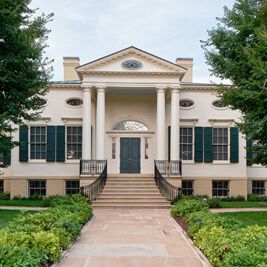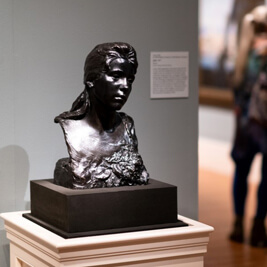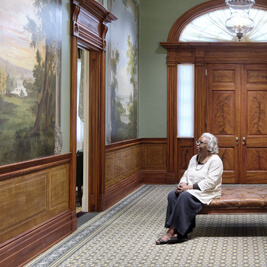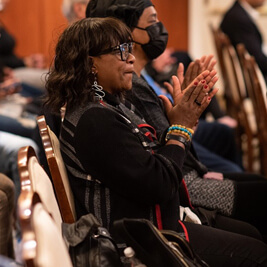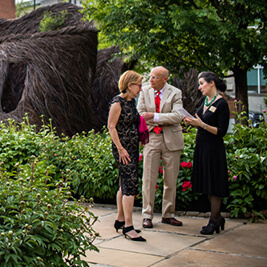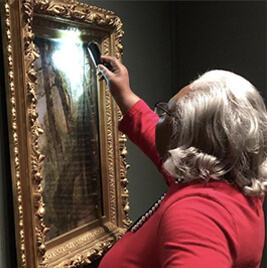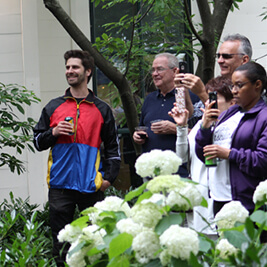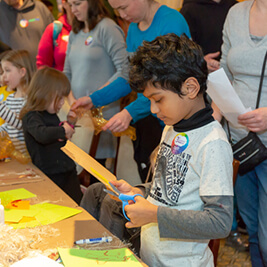- Do + See
- Dine + Host
- Give + Join
- Educate + Learn
Bicentennial Infrastructure Project Update | May 2021
The major work for the Bicentennial Infrastructure Project—removing the siding on the historic house and adding a moisture barrier—was originally scheduled for winter 2020. However, due to the pandemic, the work was delayed and now has a projected completion date of spring 2022. Certain portions of the project were able to go on as scheduled, however, including installation of an updated HVAC system in the 2004 expansion as well as much behind-the-scenes work to help secure the safety and security of our museum. With the new HVAC system, we have seen that climate control for the Fifth Third Gallery and collections storage is much improved, and so we are very excited about the outcome of the final phase of the project.
Beginning in June 2021, portions of the permanent collection will be placed in storage as part of this intensive and invasive preservation. By August, the historic home will be temporarily inaccessible to museum visitors and members. However, you can still see our top 80 works on display in the In a New Light exhibition in the Fifth Third Gallery, and another 40 or so paintings at Borrowed Gems, an exhibition of Taft works at the Cincinnati Museum Center.
Deinstalling a world-class art collection is no small undertaking, and our curatorial team has been planning for this for many years. However, it is impossible to deinstall all of the art because eight murals—the famous Robert S. Duncanson murals—are painted directly on 200-year-old plaster inside the historic home.
Not-So-Good Vibrations
The Duncanson murals have largely defined all the enhanced safety protocols we must take during the Bicentennial Infrastructure Project. Although there are other considerations, such as the climatic conditions surrounding the murals during removal of the façade and installation of the moisture barrier and insulation that will better support our new HVAC systems, vibration is a significant concern during the time of preservation.
The Taft will be strictly monitoring renovation vibration. We are working with Arne Johnson (from Wiss, Janney, Elstner Associates Inc., of Chicago), a top expert in vibration protection in historic and cultural properties, to ensure through extensive materials testing that preservation work does not harm the murals. Johnson has assisted us in creating an approach that allows the work to be successfully and safely completed by putting in place adequate vibration monitoring and protection.
This is not our first time working with Johnson. You may remember the construction in Lytle Park/Lytle Tunnel completed in 2016. Unfortunately, the Taft Museum of Art historic house present preservation project will have far more impact than the vibrations from the Lytle project. To be effective, the monitoring of vibrations must be sited between the source of the vibration and the artwork being protected by monitoring. For the Lytle Tunnel work, we knew approximately where vibration would originate outside our property and could place a single vibration sensor in the basement between the ground and the murals, and this was adequate for protection purposes to immediately notify workers if the threshold for vibrations had been surpassed.
For the present project, the monitoring requirements are more complex. We will have workers removing and reinstalling siding, digging around the foundations, cutting channels in the concrete slab under the Charles H. Dater education classroom, and moving heavy equipment in the attic. Any of these activities could cause vibration, so we are setting in place a network of sensors to monitor vibration measurements on all protected surfaces in three dimensions. If the sensors detect vibrations over a certain threshold, the workers will be immediately notified, and work will be suspended. The diagram below shows the arrangement of the sensors, which measure movement in all three dimensions at each measurement point, as well as strain potentiometers, which measure movement across a surface.

Image courtesy of Wiss, Janney, Elstner Associates, Inc. (WJE)
Why the High Cost of Vibration Control?
The Duncanson murals are invaluable, and the cost of protecting them during preservation is high. Contractors must account for specialist methods of work in their plans, using tools or techniques selected because they minimize vibration, but often not the most efficient from a time or cost perspective. They must also plan a delivery timeline with latitude for potential vibration-related delays, where the Taft’s consultants must investigate the cause of any vibration incident before work can continue on. The Taft is working with Arne Johnson to support the vendor bidding process and their training of their employees, to ensure they fully understand the specialist needs of this projects— not so much of worrying about “What happens if I drop a toolbox in the attic?”, but thinking outside of that (tool)box on the best methods and equipment to use to get the job done safely.
Want to learn more about how you can help fund our Bicentennial Infrastructure Project and protect the Taft historic house for generations to come? Visit our Love This House campaign page to learn how you can show your support.
